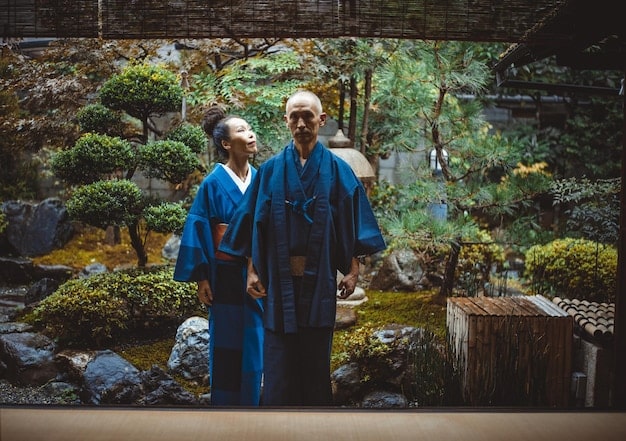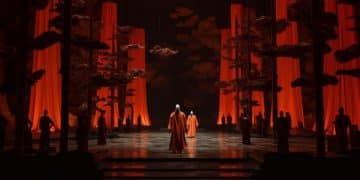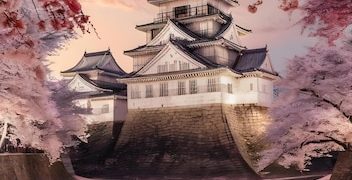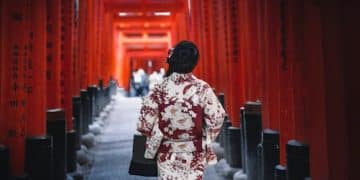Decoding Japanese Drama: Cultural References & Traditions

Advertisements
Japanese drama cultural references offer a window into Japan’s rich heritage, revealing the significance of traditions, customs, and societal values woven into the narratives.
Japanese dramas, often called “jdramas,” are more than just entertainment; they’re cultural ambassadors. Understanding the cultural references in Japanese dramas enriches the viewing experience and provides valuable insights into Japanese society. Let’s explore the world of Japanese drama cultural references and their significance.
Anúncios
The Importance of Cultural Context in Japanese Dramas
Japanese dramas are deeply rooted in the nation’s history, traditions, and societal norms. To fully appreciate the nuances of these stories, it’s crucial to understand the cultural context in which they are set. This includes recognizing the significance of certain customs, behaviors, and beliefs that may not be immediately apparent to viewers from other cultures.
The way characters interact, the settings they inhabit, and even the conflicts they face often reflect real-world aspects of Japanese life. Ignoring these cultural elements can lead to misinterpretations and a diminished appreciation of the drama’s message.
Anúncios
Understanding Japanese Etiquette and Manners
Japanese etiquette plays a significant role in jdramas. From bowing to using honorifics, these customs reflect the importance of respect and social harmony.
- Bowing (Ojigi): Different types of bows signify varying levels of respect, from casual greetings to formal apologies.
- Honorifics (Keigo): The use of suffixes like “-san,” “-sama,” and “-sensei” indicates the social hierarchy and the relationship between speakers.
- Gift-Giving (Omiyage): Presenting gifts is a common practice, especially when returning from trips, and the manner of giving and receiving is carefully observed.
Understanding these nuances allows viewers to grasp the underlying dynamics between characters and the social implications of their actions. A seemingly simple bow can convey a wealth of information about a character’s status, intentions, and emotional state.
In essence, Japanese dramas offer a lens through which viewers can observe and learn about the intricate social codes that govern interactions in Japan. By paying attention to etiquette and manners, audiences can gain a deeper understanding of the cultural values at play.
In conclusion, the cultural context is the bedrock upon which Japanese dramas are built. By understanding the significance of traditions, customs, and societal values, viewers can unlock a deeper level of appreciation for the stories and characters they encounter on screen.
Traditional Arts and Their Depiction
Traditional arts such as calligraphy (shodo), flower arrangement (ikebana), and tea ceremony (chado) are frequently depicted in Japanese dramas, showcasing their cultural significance.
These arts are not merely hobbies but refined disciplines that embody Japanese aesthetics and philosophy. They emphasize harmony, balance, and mindfulness, and their presence in dramas adds depth and symbolism to the narrative.
Calligraphy (Shodo)
Shodo is the art of brushstrokes, where each stroke carries meaning and reflects the artist’s inner state. In dramas, shodo can represent a character’s self-expression, discipline, or spiritual journey.
Flower Arrangement (Ikebana)
Ikebana is more than just arranging flowers; it’s about creating harmonious compositions that reflect the natural world. It embodies the principles of minimalism and balance, and in dramas, it can symbolize relationships, emotions, or transitions.
The tea ceremony, or chado, is a ritualized way of preparing and drinking tea. It is a performance steeped in tradition, emphasizing simplicity, respect, purity, and tranquility.
- Harmony (Wa): The tea ceremony promotes harmony between people and nature.
- Respect (Kei): Respect is shown to the tea, the guests, and the host.
- Purity (Sei): The setting and utensils are kept meticulously clean to symbolize purity.
- Tranquility (Jaku): The ceremony is conducted in a quiet and peaceful atmosphere, encouraging mindfulness and contemplation.
These traditional arts are not just decorative elements; they are integral parts of the storytelling, offering insight into the characters’ values and the themes of the drama.
Ultimately, the depiction of traditional arts in Japanese dramas serves as a reminder of the enduring importance of these cultural practices in modern Japanese society. They connect characters to their heritage and provide viewers with a glimpse into the beauty and philosophy of these art forms.
Festivals (Matsuri) and Seasonal Events
Festivals (matsuri) and seasonal events are integral to Japanese culture and often featured in dramas, providing colorful and lively backdrops.
These events are not only celebrations but also opportunities to connect with traditions, community, and the changing seasons. They offer a vibrant representation of Japanese life and provide a context for characters to interact and develop.
Summer Festivals (Natsu Matsuri)
Summer festivals are characterized by colorful yukata (summer kimonos), lively music, and traditional dances. They often feature food stalls, games, and fireworks displays.
Cherry Blossom Viewing (Hanami)
Hanami is the tradition of enjoying the beauty of cherry blossoms in full bloom. It’s a time for picnicking, socializing, and appreciating the transient nature of life.
New Year’s is one of the most important holidays in Japan. It is a time for family gatherings, special foods, and visits to shrines and temples.
- Family Gatherings (Toshidama): Families gather to celebrate and exchange gifts, especially for children.
- Special Foods (Osechi Ryori): Elaborate New Year’s dishes are prepared, each with symbolic meaning for good luck and prosperity.
- Shrine Visits (Hatsumode): People visit shrines and temples to pray for good fortune in the coming year.
Festivals and seasonal events offer a glimpse into the cultural values that shape Japanese identity. They are times for celebration, reflection, and connection, and their presence in dramas adds richness and authenticity to the storytelling. The events provide context for characters to interact and develop, and also showcase the beauty of Japanese traditions.
As a result, by incorporating festivals and seasonal events, Japanese dramas provide audiences with a deeper understanding of the cultural fabric that binds the nation together.
Food Culture: Symbolism and Significance
Food culture is deeply ingrained in Japanese society, and its symbolism is often reflected in dramas, highlighting its social and emotional significance.
Meals are not merely about sustenance; they are opportunities for connection, communication, and the expression of emotions. The way food is prepared, presented, and consumed reflects Japanese aesthetics and values.
Bento Boxes (Obento)
Bento boxes are carefully arranged meals, often prepared with love and attention to detail. They are a symbol of care, nurturing, and connection, and in dramas, they can represent relationships and emotional bonds.
Ramen and Comfort Food
Ramen is a popular and affordable dish, often associated with comfort and nostalgia. In dramas, it can symbolize simple pleasures, friendship, and hard work.
Tea is an integral part of Japanese culture, and its preparation and consumption are steeped in tradition. It is a symbol of hospitality, respect, and mindfulness.
- Green Tea (Ryokucha): The most common type of tea, often served with meals or during gatherings.
- Matcha: A powdered green tea used in the tea ceremony, known for its vibrant color and rich flavor.
- Tea as Hospitality: Offering tea to guests is a sign of welcome and respect.
Food-related scenes in dramas often serve as pivotal moments in the narrative, revealing characters’ emotions, relationships, and cultural values. From the elaborate presentation of a traditional meal to the simple act of sharing ramen, food becomes a powerful tool for storytelling.
Consequently, the depiction of food culture in Japanese dramas provides a deeper understanding of the social and emotional significance of meals in Japanese society.
Social Issues and Modern Life
Japanese dramas frequently tackle social issues and modern life challenges, reflecting the realities and concerns of contemporary Japanese society.
These dramas explore a range of topics, from workplace dynamics and family relationships to social inequality and mental health. They provide a platform for discussing important issues and raising awareness among viewers.
Workplace Culture (Salaryman Life)
Many dramas depict the demanding and competitive nature of Japanese workplace culture, often focusing on the lives of “salarymen” (office workers) and the pressures they face.
Family Dynamics and Intergenerational Relationships
Dramas explore the complexities of family relationships, often highlighting the challenges of intergenerational communication and the changing roles of family members.
Social issues such as bullying, discrimination, and mental health are increasingly addressed in Japanese dramas, reflecting a growing awareness and desire for change.
- Bullying (Ijime): Dramas often depict the devastating effects of bullying on individuals and communities.
- Discrimination (Sabetsu): Issues of discrimination based on gender, ethnicity, and social status are explored.
- Mental Health (Seishin Hoken): Dramas are shedding light on mental health issues and promoting understanding and support.
By addressing difficult and sensitive topics, these dramas contribute to a broader conversation about social change and progress in Japan. They offer a glimpse into the challenges that individuals and communities face and encourage viewers to reflect on their own values and beliefs.
Therefore, by tackling social issues, Japanese dramas serve as a powerful medium for social commentary and change, reflecting the realities and concerns of modern Japanese society.
Pop Culture and Trends
Pop culture and current trends play a significant role in Japanese dramas, reflecting the ever-evolving tastes and interests of the younger generation.
From fashion and music to technology and social media, these elements add a contemporary flair to dramas and help to connect with younger audiences. They provide a snapshot of modern Japanese life and showcase the latest trends and cultural phenomena.
Fashion and Style
Dramas often showcase the latest fashion trends, from street style to high-end designer brands. They influence viewers’ fashion choices and reflect the importance of appearance in Japanese society.
Music and Entertainment
J-pop (Japanese pop music) and other forms of entertainment are frequently featured in dramas, providing a soundtrack to the characters’ lives and reflecting popular tastes.
Technology and social media are integral to modern life, and dramas often incorporate these elements to reflect the way people communicate and interact in the digital age.
- Smartphones and Apps: Characters use smartphones and apps to connect with each other and access information.
- Social Media: Social media platforms like Twitter and Instagram play a role in storytelling, reflecting the impact of online communication.
- Gaming and Internet Culture: Dramas often feature characters who are passionate about gaming and internet culture, reflecting the growing popularity of these activities.
By incorporating elements of pop culture and current trends, Japanese dramas remain relevant and engaging to younger audiences. They reflect the changing landscape of Japanese society and showcase the latest trends and cultural phenomena.
In summary, the inclusion of pop culture not only enhances the contemporary feel of jdramas but also offers insights into the evolving lifestyles and preferences of the younger generation in Japan.
| Key Element | Brief Description |
|---|---|
| 🎎 Traditions | Highlight the deep-rooted customs influencing behaviors. |
| 🍵 Arts | Feature calligraphy, tea ceremony, and flower arranging. |
| 🍜 Food | Illustrate role of meals, from bento boxes to ramen. |
| 🎉 Festivals | Show summer festivals, hanami, and New Year customs. |
Frequently Asked Questions
▼
Cultural references are essential because they provide viewers with a deeper understanding of Japanese society, values, and norms, enhancing the viewing experience. They reflect real-world aspects of Japanese life.
▼
Traditional arts like calligraphy and tea ceremony provide insight into characters’ values and themes within the drama. They embody Japanese aesthetics and philosophies such as harmony and balance.
▼
Japanese dramas often tackle social issues like workplace culture, mental health, bullying, and discrimination, reflecting concerns and promoting understanding and awareness among viewers.
▼
Festivals and seasonal events provide colorful, lively backdrops for dramas, connecting viewers with Japanese traditions. These times for celebration, reflection, and connection enrich the storytelling.
▼
Food culture highlights the social and emotional significance of meals. The ways food is prepared, presented, and consumed reflect Japanese aesthetics and values which show emotion, relationships and cultural values.
Conclusion
In conclusion, understanding Japanese drama cultural references enriches the viewing experience by providing insights into traditions, customs, and societal values woven into the narratives.





